Tech Tips 4.6L Mustang
What rear differential gear do you recommend?
2V GT: The GT reacts to gear changes much the same way a 5.0 does although the real problem is that they have less torque than a 302.
For stick cars we recommend 3.73 gears. Because of the lack of low end torque, we don’t feel 3.55’s are enough. The 3.73 gives an excellent increase in acceleration and top speed isn’t decreased because you are able to wind out overdrive further. With a 3.73 your rpm in 5th gear at 60 mph will only be 2005, not at all what you might call “too high”. As we said, your top speed will not decrease when putting lower (numerically higher) gears in a car with overdrive. You will simply wind out 5th gear further than you could with the higher gears (numerically lower).
For AODE cars, 3.73’s are still a good choice but we recommend 4.10 gears. A 4.10 may sound extremely steep, but because the AODE’s 1st gear is higher (numerically low) and 4th gear (overdrive) is steeper than the T-5, it’s a very good choice for the driver interested in making their car perform better.
4V Cobra: The Cobra has an entirely different engine than most people are used to. It performs best at high rpms, upwards of 7000. It’s power band is relatively high due to the deep breathing nature of the two intake valves. When gearing a Cobra, 3.73’s just aren’t enough. They don’t allow the engine to reach its power band quickly enough. 4.10 gears are an excellent choice and 4.30’s are even better. This may sound very steep if you’re used to the average 5.0 which needs to be shifted by 5600 rpm. But since this engine will easily rev to 7000 it needs the extra gear and it likes it. 4.30’s are our #1 choice, naturally aspirated or supercharged. At 80 mph in fifth with 4.10’s the engine only turns about 2700 rpm, completely tolerable.
I want to upgrade the exhaust system on my Mustang, what do you think?
2V GT: Traditionally, a free flowing exhaust system has always been an excellent way of increasing overall power. The 4.6L is no different but responds differently than a traditional 302.
Ford Motorsport makes a very nice set of headers for the 96 – 98 Mustang GT. They use a high tech coating to keep them from rusting and ensure long life. Their primary tubes are 1 5/8″ and they offer a noticeable gain.
The most important thing to remember when choosing a high flow H-Pipe and catalytic converters is that the 2V engine is very sensitive and easily looses torque if the exhaust is too large. We recommend a 2 1/4″ h-pipe, any larger and low end torque suffers significantly. And low end torque is what this engines needs improved the most. The Motorsport headers and a good h-pipe are worth approximately 25 hp.
4V Cobra: We have done extensive dyno testing with the Cobra’s exhaust and found significant gains by using both headers and a free flowing h-pipe with converters.
As with the 2V engine, the 4V is sensitive to the size of the exhaust and can suffer torque losses if it is too large. We’ve used, with great success, a 2 1/4″ h-pipe / converter set up that by itself is worth 15-18 horsepower. We have also dyno’d a set of stainless steel headers that by themselves are worth 25 hp and when combined with the h-pipe are worth 50 hp.
What are a few simple bolt-ons I can do for additional power?
Unfortunately, there aren’t as many simple bolt-ons for the 4.6L engine as there are for the 5.0. But there are a few that are economical and make a difference.
Probably the best bang-for-the-buck you can do is putting in a lower (numerically higher) differential gear. One of the tech questions in this section address which one to choose.
Under-drive pulleys are always a good choice and are very affordable. Under-drive pulleys free up horsepower that was being used to turn your alternator and water pump. They slow down the operation of these accessories and allow the crank to spin easier. They’ll add about 15 hp to your GT or Cobra.
A K&N air filter is also a good bolt-on that doesn’t cost much. K&N Air Filters are constructed out of a high quality cotton fiber that is sandwiched between a metal screen. They offer the lowest restriction of any air filter on the market which means more power and better mileage. K&N air filters are washable and reusable and feature a 1 Million Mile Warranty.
Free flowing exhaust can get kind of pricey when compared to these other bolt-ons and isn’t really much of a bolt-on. But once you’ve made these other modifications it’s the next logical choice for affordable power.
Tell me more about supercharging my 4.6L Mustang.
Supercharging your Mustang is one of the most effective and substantial ways to increase its power and performance. When done properly, a supercharger offers an astounding increase in power without hurting gas mileage or overall drivability.
The only superchargers we carry are Vortech Superchargers because they are the best engineered, best built and most powerful available. Manufactured to strict aircraft tolerances, Vortech Superchargers offer an OEM-like quality, fit and finish. The kits fit like they were designed and installed by Ford. And the kits come complete with everything you need for the installation including auxiliary fuel pump and all hardware.
Vortech’s S-Trim supercharger is the industry’s most efficient and powerful street supercharger. It can supply more air than any other street unit available. And the 32V Cobra needs a blower capable of supplying large volumes of air. It is perfectly suited to the 4.6L engine and makes a substantial increase in power. Read more about supercharging the 4.6L in our Water Box Archives.
With a set of slicks and a 3.73 gear, an otherwise stock GT is capable of 13.40’s @ over 102 mph and a Cobra with slicks and 4.30 gear is capable of 12.10’s at over 114 mph. Of course, with street tires you won’t be able to turn these kind of numbers, but the power will still be there.
Does nitrous oxide work well on the 4.6L engines?
Nitrous is still an economical way of adding a significant amount of power to any vehicle. And as long as it’s installed properly, there is no danger of blowing up your engine as many people say. Nitrous has been called the “Poor Man’s Supercharger”. It does the same thing as a supercharger, supplies the engine with more oxygen than it would normally see. Only it does it chemically instead of mechanically.
We’ve had excellent results adapting the standard 5.0 Mustang NOS Dry Flow system to the 4.6L Mustang. And as with the 5.0, expect to add about 70 hp, a little more with additional modifications. The only real concern is that the 2V 4.6L uses a composite intake manifold. In the event of a nitrous backfire, this intake can crack and need to be replaced. But if the kit is set up and used properly, this is not a danger.
I’ve done everything you said and when I took my car to the drag strip it wouldn’t even run 13’s!
Your car could have 500 horsepower but if you can’t get it to the ground it doesn’t do any good. Perhaps the most important piece of equipment you need to make a car run good numbers is a set of slicks. Even on the street if you’re interested in leaving the line before the other guy you need traction. Peeling out may have been cool when we were teenagers, but when you’re making real power and trying to get it to the ground tire spin isn’t cool, it’s a problem.
We’ve seen completely stock Mustangs with a set of slicks pull away from mildly modified cars that are defiantly making more power. In a race, if someone puts two or three car lengths on you right out of the gate it’s always difficult to catch up. As a general rule of thumb, a good pair of slicks is worth 4 tenths, although cars making more power will benefit even more.
A few years ago when our ’88 LX was running low 11’s, we put a pair of street tires on just for fun. The tires were awfully wide, 295’s to be exact but they were still just a radial street tire. The car couldn’t even get into the 12’s! It ran a couple 13.0’s but couldn’t go any quicker. We were spinning tire almost to the 1/8 mile mark feathering the throttle the whole way. After bolting the slicks back on the car promptly ran 11.20’s. So in our case the slicks were worth 1.8 seconds, that’s roughly 18 car lengths in a race!
So now you’re asking what kind of slicks should you buy. We’ve found Mickey Thompson, Goodyear, Hoosier and Firestone to be excellent choices, although the Mickey’s seem to offer the best traction at the strip and on the street. If you’re driving on the street and don’t want to run the risk of getting caught with non-DOT tires, M & H DOT slicks aren’t bad, but they’re not as good as a true slick. Mickey Thompson now offers their ET Street, which has D.O.T. approval and works as well as their ET Drag. If that’s still too serious for you and you’re looking for a full tread tire, Mickey Thompson Sportsman Pro’s, Hoosier Quick Times and BFG Drag Radials are the next best choice. Once you’ve got a good tire on the car, traction bars like Mega-Bites are the next logical step and work well in putting power where it should be.
How much will traction bars help my car?
H.P. Motorsports’ Mega-Bite traction bars do a good job of planting the rear tires and eliminating wheel hop. If you’re not using slicks or a sticky tire, traction bars won’t do much more than eliminate wheel hop. But if you have a pair of slicks, traction bars can give you the needed traction to pull a wheelie off the starting line. Polyurethane bushings on the rear control arms are also an effective way to increase traction and handling.
My friend and I have identical modifications but his car always seems to beat me, why?
Driving style and shifting can make a big difference in cases like these. A Hurst shifter can really decrease the amount of time spent in between gear changes and allows more precise shifts. Power shifting can be worth up to two tenths over granny shifting if you’re willing to take the chance of missing 3rd gear and buying a new T-5. Also, try to limit tire spin as much as possible, find a happy medium between peeling out and bogging. The launch is very important and many races are decided by who leaves the hardest.
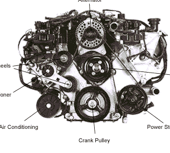
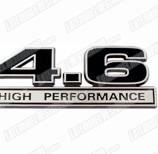

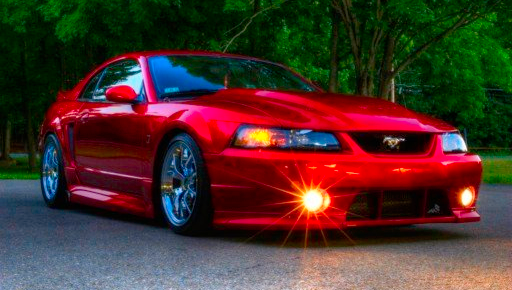

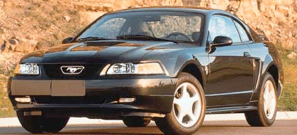
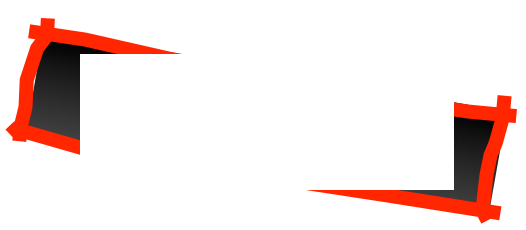

4.6L Mustang Tech Q&A
